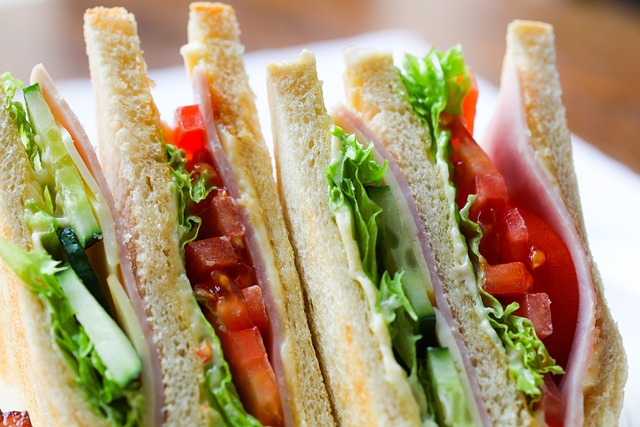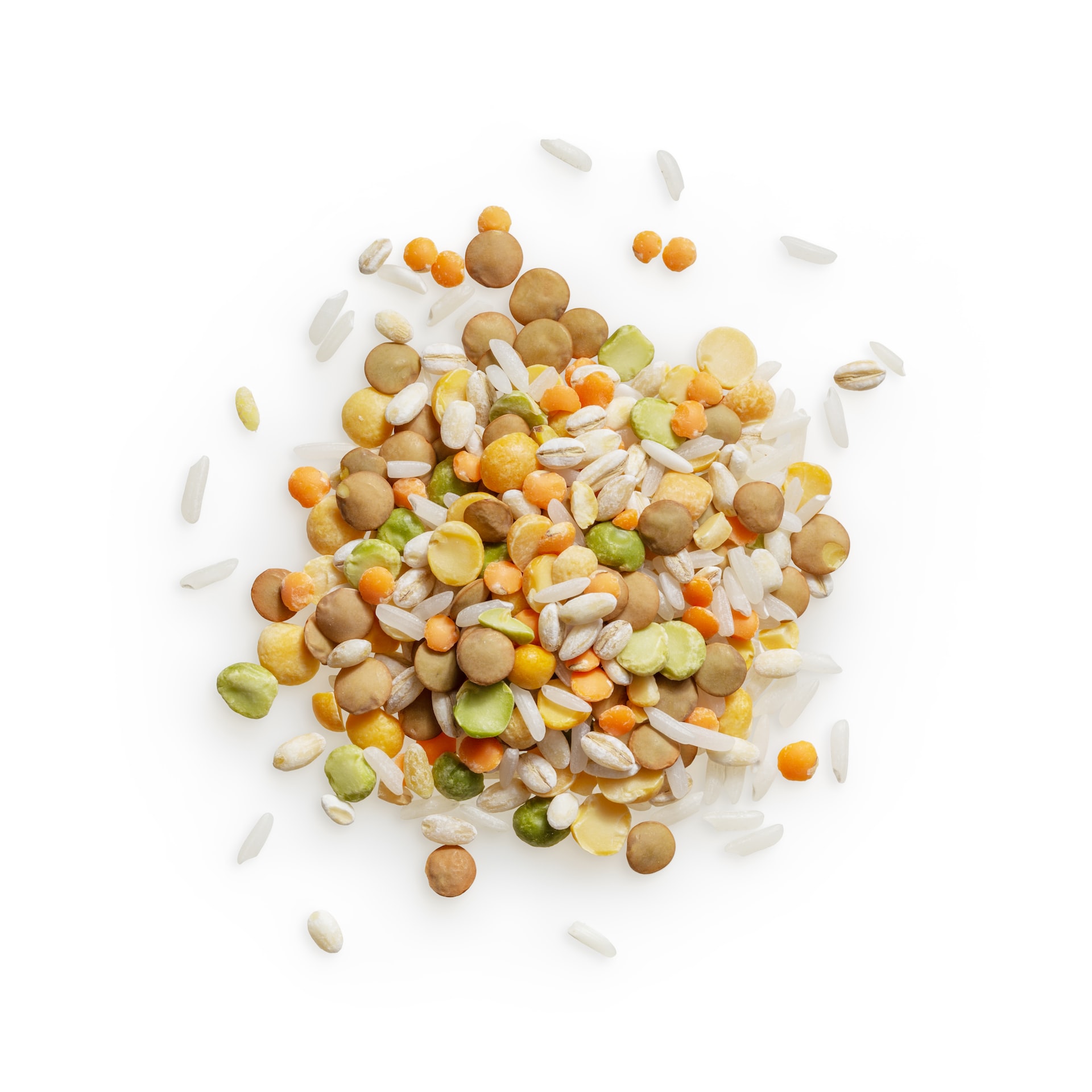Nutritional Value of Sandwiches
When exploring the nutritional value of sandwiches, a critical question emerges: Are they really unhealthy?
The answer lies in our ingredient choices. Just like an artist curates colors, we can select ingredients that lift our sandwiches from ordinary to extraordinary.
Many sandwiches rely on processed meats, infamous for their high sodium and unhealthy fats. A typical deli meat sandwich can be a calorie-laden trap, brimming with preservatives. But imagine swapping that processed meat for lean turkey or grilled chicken—suddenly, our sandwich transforms into a nutrient-packed delight!
To create a balanced sandwich, focus on these necessary elements:
- Whole Grains: Opt for whole grain bread instead of white. This choice boosts fiber content and keeps you feeling full longer.
- New Vegetables: Incorporate lettuce, tomatoes, and cucumbers for a burst of flavor and a wealth of vitamins and minerals.
- Healthy Fats: Replace mayonnaise with avocado or hummus for a creamy, nutritious twist.
Portion size is critical too. A sandwich can be a convenient meal, but overloading it with cheese and condiments can turn it into a calorie bomb. Think of yourself as the chef, crafting sandwiches that align with your health goals.
So, are sandwiches bad for you?
Not at all! They can fit seamlessly into a balanced diet with smart choices. Visualize them as a canvas; the ingredients we choose paint the picture of our health. By opting for new ingredients and being mindful of additions, we can enjoy sandwiches without guilt.
| Ingredient | Nutritional Impact |
|---|---|
| Processed Meats | High in sodium and unhealthy fats |
| Whole Grain Bread | Rich in fiber, promotes fullness |
| New Vegetables | Adds vitamins, minerals, and fiber |
| Cheese | Can be high in fat; opt for low-fat options |
Sandwiches can be a healthy choice when approached wisely. By prioritizing new ingredients and mindful portions, we can savor this versatile meal without compromising our health.
Impact of Processed Meats on Health
When we think of sandwiches, do we ever pause to reflect on the impact of processed meats on our health?
While convenient, processed meats like deli slices and hot dogs carry hidden dangers.
These meats often contain excessive sodium—think of it as the salt that can spoil a dish. Just as too much sugar can ruin a cake, high sodium levels can lead to serious health issues, such as high blood pressure. Imagine your body as a car: too much sodium is like overfilling the gas tank—eventually, it leads to breakdowns.
Processed meats are also loaded with calories and fats. A simple ham sandwich can quickly transform into a calorie bomb if we’re not careful. Is that ham worth the potential health risks?
To make our sandwiches healthier, consider replacing processed meats with lean proteins like grilled chicken or turkey. Opting for whole grains as the base enhances nutritional value. Whole grain bread serves as a sturdy bridge, supporting our health with fiber and necessary nutrients.
Don’t underestimate the power of vegetables. A colorful mix of veggies can lift our sandwiches from mundane to magnificent. Think of vegetables as dynamic paint on a canvas; they improve flavor and deliver a nutritional punch.
| Ingredient | Health Impact |
|---|---|
| Processed Meats | High in sodium and unhealthy fats |
| Whole Grains | Rich in fiber and nutrients |
| New Vegetables | Packed with vitamins and minerals |
By choosing new ingredients and making mindful decisions, we can craft a balanced diet. Enjoy your sandwiches while prioritizing your health. So, the next time you reach for a sandwich, think about its ingredients—after all, we truly are what we eat!
Caloric Content and Weight Management
When it comes to caloric content and weight management, sandwiches can be both friends and foes. Are they nourishing allies or sneaky saboteurs in our quest for a healthy diet?
Like a double-edged sword, their impact hinges on the ingredients we choose.
Imagine a sandwich as a blank canvas. You can paint it with dynamic vegetables, lean proteins, and whole grains, or you can smother it with processed meats, fatty cheese, and sugary condiments. Each ingredient shapes the calories and fats we consume. A sandwich loaded with new components can be a nutrient powerhouse, while one stuffed with preservatives can lead us astray.
Consider these two sandwich scenarios:
| Sandwich Type | Health Impact |
|---|---|
| Whole Grain Turkey Sandwich | Low in calories, high in protein and fiber |
| Processed Meat & Cheese Sandwich | High in sodium and saturated fats |
The portion size and ingredients of a sandwich play a critical role in our health. While they offer convenience, we must prioritize nutritional value. Relying solely on sandwiches can create imbalances if we neglect new ingredients and vegetables.
How can we make healthier choices?
Here are some tips:
- Lean Proteins: Choose turkey, chicken, or plant-based options.
- Whole Grains: Opt for whole grain or sprouted bread.
- New Vegetables: Load up on lettuce, tomatoes, and cucumbers.
- Mindful Portion Sizes: Be aware of how much you’re eating.
Sandwiches can be part of a balanced diet when approached wisely. By making informed choices, we can enjoy our sandwiches without compromising our health or weight management goals. Are you ready to accept the sandwich as a healthy ally?
Sodium Intake and Health Risks
Sandwiches are often a quick and tasty meal, but have you considered the hidden sodium intake? Sodium, prevalent in processed meats and cheeses, poses a significant health risk.
Imagine sodium as a stealthy thief lurking in our sandwiches, particularly in deli meats and condiments. These ingredients can dramatically lift sodium levels, leading to serious health issues. High sodium intake can cause high blood pressure, much like over-inflating a balloon—it’s bound to pop!
When enjoying a sandwich, keep these factors in mind:
- Processed Meats: Often packed with sodium, they can stealthily increase our daily intake.
- Cheese: Delicious but can remarkably add to sodium and fat content.
- Portion Size: Larger sandwiches mean more sodium. Are we truly aware of our consumption?
Not all sandwiches are created equal. We can make healthier choices by opting for whole grains, loading up on new vegetables, and choosing lean proteins. Think of your sandwich as a canvas; the more colorful the ingredients, the healthier the masterpiece!
Research shows that meals high in sodium often lead to increased calorie and fat intake. A study in the journal Public Health found that on days when people ate sandwiches, they consumed more calories, fats, and sugars. Are we sacrificing health for convenience?
Let’s compare two sandwiches:
| Sandwich Type | Sodium Content (mg) |
|---|---|
| Turkey & Cheese | 1,200 |
| Veggie & Hummus | 400 |
Choosing a veggie sandwich not only lowers sodium but also boosts fiber intake. Isn’t it time to rethink our sandwich choices?
By prioritizing new ingredients and being mindful of sodium, we can enjoy our meals without compromising our health.
Role of Whole Grains in Sandwiches
Whole grains are the backbone of sandwiches that are both tasty and nutritious. Ever wondered why some sandwiches leave you energized while others drag you down?
The answer often lies in the bread choice. Whole grain bread is like a sturdy ship, skillfully finding your way the turbulent waters of processed foods.
Packed with fiber, whole grains are necessary for digestive health. Imagine fiber as a broom, sweeping away the clutter in our digestive system and testing everything running smoothly. Whole grain bread not only fills our bellies but also delivers critical nutrients that support a balanced diet. On the contrary, white bread, made from refined grains, lacks these nutrients and can lead to blood sugar spikes.
What about common sandwich staples like processed meats, cheese, and condiments?
While they add flavor, they often come with excess sodium, fats, and calories—like storm clouds overshadowing our healthy whole grains. To create a balanced sandwich, prioritize new vegetables, lean proteins, and wholesome condiments.
Here’s how to build a healthier sandwich:
- Choose whole grains: Opt for whole grain bread or wraps to optimize nutrition.
- Limit processed meats: Select lean proteins like grilled chicken or turkey instead of high-sodium deli meats.
- Add vegetables: Load your sandwich with new ingredients like spinach, tomatoes, or peppers for added vitamins.
- Be cautious with condiments: Use mustard or hummus instead of mayonnaise to cut down on unhealthy fats.
By making these mindful choices, sandwiches can become a healthy part of our diet. They offer convenience and can be tailored to meet our nutritional needs. But, relying on sandwiches filled with unhealthy ingredients and preservatives can undermine our health.
The role of whole grains in our sandwiches transcends taste; it’s about making choices that improve our well-being. By being intentional with our ingredients, we can savor delicious sandwiches without compromising our health.
Balancing Ingredients for a Healthier Sandwich
Are sandwiches unhealthy?
The answer lies in how we construct them. Think of a sandwich as a canvas, where each ingredient adds dynamic color to our culinary creation. By balancing our choices, we can design a healthier sandwich that enhances our diet.
Nutrition is critical. A sandwich can be a nutrient powerhouse when we prioritize whole grains, lean proteins, and a variety of vegetables. Whole grain bread provides a sturdy base, packed with fiber and energy, while white bread is like a house of cards—fragile and lacking necessary nutrients.
Processed meats, often found in sandwiches, can be loaded with high sodium and unhealthy fats. Choosing lean, unprocessed proteins like grilled chicken or turkey can dramatically reduce health risks linked to high-calorie diets. Ever noticed how a veggie-packed sandwich leaves you feeling more satisfied than one stuffed with greasy meats?
That’s the power of new ingredients!
When it comes to condiments, moderation is critical. A dollop of mayonnaise can turn a healthy sandwich into a calorie bomb. Instead, opt for mustard or hummus for flavor without the extra calories. Portion size matters too; a sandwich the size of a football can easily exceed your daily calorie needs. Aim for a size that satisfies without overwhelming your intake.
Don’t underestimate cheese. While it adds creaminess and flavor, it often brings extra calories and fats. Choosing low-fat cheese or using it sparingly helps maintain balance. Think of cheese as the cherry on top—delicious in moderation, but too much can spoil the entire dish.
Sandwiches aren’t inherently bad. By making informed ingredient choices, we can enjoy a delicious lunch that supports our health. Explore sandwich alternatives like lettuce wraps or grain bowls to keep meals exciting and nutritious. Remember, we hold the brush to our culinary canvas; let’s paint it with health!
Portion Control and Obesity Prevention
When we consider portion control, we often wonder how it shapes our food choices, particularly with sandwiches. Are sandwiches unhealthy?
The truth is more complex than a simple yes or no. Just like an artist curates colors for a masterpiece, we can select ingredients that lift our sandwiches into nutritious meals.
Visualize a sandwich as either a nutritional powerhouse or a calorie bomb, depending on our choices. By choosing whole grain bread, lean proteins like turkey or chicken, and new vegetables, we create a balanced meal. On the contrary, processed meats, high-fat cheeses, and sugary condiments construct a tower of unhealthy options.
Think of a sandwich as a garden. It thrives on new ingredients, just as a garden flourishes with fiber-rich vegetables and wholesome grains. But, an overload of preservatives and unhealthy fats is like dousing our plants with chemicals; it stunts growth. Excessive sodium and calories can lead to serious health issues, including obesity.
Here’s how to build a health-supporting sandwich:
- Choose whole grains: They offer more fiber and nutrients.
- Limit processed meats: Opt for lean, unprocessed proteins.
- Add veggies: They increase volume and provide necessary vitamins.
- Watch the condiments: Use them sparingly to manage calories.
Portion size is critical. A sandwich the size of a small car can lead to excess, while a manageable size satisfies without overwhelming our bodies with calories. It’s all about finding balance.
Sandwiches aren’t inherently bad; they can be part of a healthy diet with mindful choices. Let’s accept our role as chefs of our own health, crafting meals that nourish both our bodies and minds.
Homemade vs. Fast Food Sandwiches
When we think of sandwiches, do we picture a quick meal that can be either a nutritious delight or a calorie overload? What truly distinguishes a homemade sandwich from one from a fast food joint such as McDonald’s or Popeyes? Is it merely the ingredients, or does the way we prepare them play a critical role?
Homemade sandwiches empower us to control every aspect. We can choose whole grain bread, stack on new vegetables, and opt for lean proteins. It’s like being a chef in our own kitchen, crafting a dish that reflects our tastes and health aspirations. On the contrary, fast food sandwiches often rely on processed meats, excessive sodium, and unhealthy fats. Imagine a factory assembly line—efficient but rarely the healthiest option.
Let’s look at the key differences:
| Aspect | Homemade Sandwich | Fast Food Sandwich |
|---|---|---|
| Nutritional Value | Packed with fiber, vitamins, and minerals | Often high in sodium and preservatives |
| Control Over Ingredients | Complete control | Limited choices |
| Portion Size | Tailored to preference | Standardized and often oversized |
Are sandwiches inherently unhealthy?
The answer lies in our choices. A sandwich can be part of a balanced diet if we fill it with wholesome ingredients and keep portion sizes in check. But, regularly opting for fast food can lead to weight gain and excessive sodium intake.
In the end, we hold the reins in making sandwiches a healthy choice. By selecting new ingredients and using lighter condiments, we can enjoy a delicious and nutritious meal. Are we ready to take control of our sandwich decisions?



